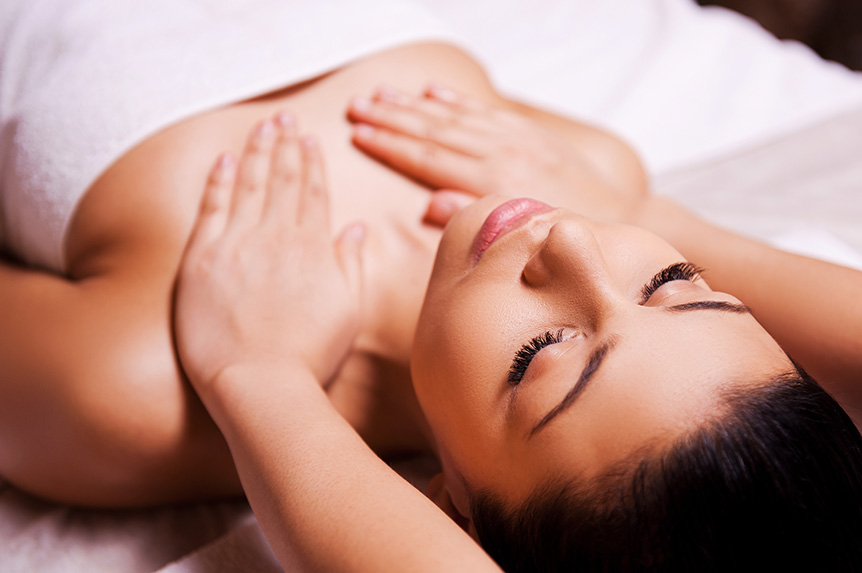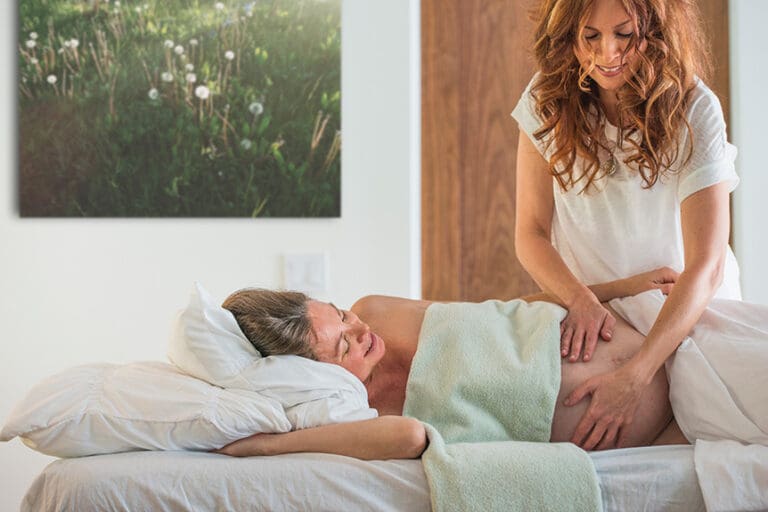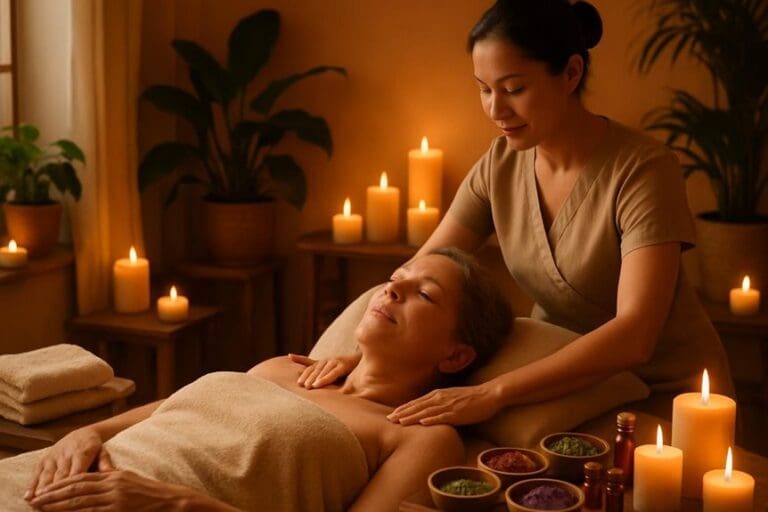Breast massage in pregnancy can be safe when performed gently, with light pressure, slow pacing, and supportive positioning (semi‑reclined or side‑lying). Non‑stimulating, hypoallergenic oils are preferred; avoid deep pressure, heat, and stimulating essential oils. Benefits may include reduced tenderness, improved lymphatic flow, and relaxation. Stop and seek medical advice for new lumps, skin changes, nipple discharge, fever, or sharp pain. First trimester warrants extra caution. With informed consent and proper technique, it supports comfort—and there is more that helps.
Is Breast Massage Safe During Pregnancy?
Breast massage can be safe during pregnancy when performed gently, with appropriate positioning, and by a trained therapist who understands perinatal care. Spa & Massage advises a light, non-stimulating approach that respects breast sensitivity and evolving anatomy.
Contraindications include unexplained breast pain, infection, skin changes of concern, or a high-risk pregnancy; in such cases, medical guidance is advised before any touch.
Clinically, safety rests on pressure control, slow pacing, and side-lying or semi-reclined positioning to protect circulation.
In our clinics, therapists avoid deep work over glandular tissue and the nipple-areolar complex, focusing instead on superficial techniques to surrounding areas, with neutral, hypoallergenic oils.
Sessions prioritize consent, draping, and clear boundaries. Clients are encouraged to communicate comfort levels throughout, ensuring care that feels respectful, intimate, and secure.
Integrating aromatherapy massage during pregnancy can further promote relaxation and healing when properly tailored to the individual’s needs and sensitivities.
Potential Benefits for Expectant Mothers
With safety parameters established, attention turns to why gentle, non-stimulating breast massage may help during pregnancy. Evidence and clinical experience suggest it can reduce local discomfort from glandular growth, support lymphatic flow, and ease fascial tightness around the chest wall.
Light, slow strokes may diminish swelling and tenderness, while gentle pectoral and axillary drainage can improve mobility and comfort with bras and sleep.
Many expectant mothers value the preparatory benefits: massage can enhance body awareness of the breast, areola, and chest muscles, aiding relaxed touch that later supports comfortable feeding positions.
In our Spa & Massage clinics, therapists use hypoallergenic, fragrance-free oils and teach soft, non-stimulating techniques partners can replicate at home, promoting calm breathing, soothing contact, and a sense of secure, grounded intimacy.
When to Avoid or Pause Breast Massage
At Spa & Massage, therapists advise extra caution with breast massage in the first trimester, keeping touch light and brief or postponing if there is any pregnancy complication.
Sessions should stop immediately with sharp pain, unusual swelling, nipple bleeding or discharge (not typical colostrum), fever, skin infection, or dizziness.
Clients are encouraged to inform their midwife or GP about any new breast symptoms and resume only when medically cleared.
First Trimester Caution
During the first trimester, caution is advised, as hormonal shifts and early placental development warrant a conservative approach to any breast work. Heightened breast tenderness, increased blood flow, and evolving ductal tissue mean even light pressure can feel intense.
From Spa & Massage’s clinical perspective, gentle self-care is appropriate: supportive bras, warm compresses, and feather-light, non-stimulating touch around—not over—the nipple-areolar complex.
If massage is considered, it should be brief, comfort-led, and limited to superficial strokes that respect sensitivity.
In our clinics, therapists avoid deep pressure, heat intensifiers, and essential oils known to be stimulating; neutral, hypoallergenic oils are preferred.
Clients are encouraged to liaise with their midwife or GP before starting any breast-focused routine.
Prioritising rest, hydration, and slow breathing often provides safer, soothing relief.
Signs to Stop Immediately
Early caution in the first trimester sets the tone for safe practice, and knowing when to stop is equally important throughout pregnancy.
Immediate cessation is advised with sharp or escalating pain, sudden breast swelling, warmth, or redness suggestive of inflammation; nipple bleeding; new lumps; fever or chills; dizziness, shortness of breath, or palpitations; uterine cramping, fluid loss, or vaginal bleeding; and any allergic response to oils.
Nipple stimulation that triggers contractions warrants pausing and consulting a midwife or GP.
At Spa & Massage, therapists avoid deep pressure, vigorous nipple work, and heat over the breasts, and use hypoallergenic, fragrance-light oils.
They recommend gentle, circular strokes only when comfortable.
If any warning sign appears, clients are guided to stop, rest, and seek medical assessment before resuming.
Gentle Techniques Our Therapists Recommend
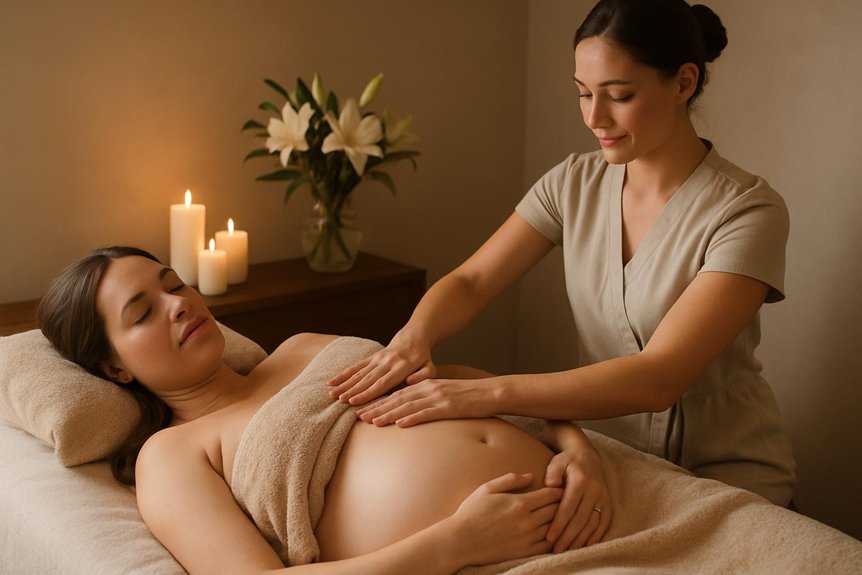
Although every pregnancy is unique, Spa & Massage therapists consistently prioritise light, slow, and non-invasive methods that support comfort, circulation, and breast tissue health. Recommended touch begins with breath-led settling, then gentle palm holds over the chest wall to invite relaxation without pressure.
Using fingertips, therapists apply feather-light effleurage from the sternum outward, following natural lymph pathways toward the axilla, avoiding any deep kneading. Small, slow circular motions around—but not directly on—the nipple complex help ease tension in surrounding tissue.
When tenderness is present, static holds and micro-movements are preferred over gliding strokes. Positioning is side-lying or semi-reclined, with cushions supporting the back and under-bust.
Sessions remain brief, continuously checking comfort, temperature, and sensitivity, prioritising safety and calm.
Using Oils and Moisturisers Safely
When selecting oils and moisturisers for breast care in pregnancy, safety hinges on simple, well-tolerated ingredients, patch testing, and gentle application.
Evidence supports choosing fragrance-free, hypoallergenic bases such as sweet almond, fractionated coconut, grapeseed, or jojoba, and bland emollients like shea or cocoa butter.
In our Spa & Massage clinics, therapists prioritise minimal-ingredient formulas and avoid essential oils in the first trimester; later, only low-dose, pregnancy-appropriate options are considered with consent.
A pea-sized amount suffices; apply with light strokes, avoiding nipple if prone to irritation.
Patch test on the inner forearm for 24 hours before first use.
Discontinue if redness, itching, or stinging occurs.
Those with eczema, nut allergy, or mastitis risk should seek midwife or GP advice.
Hydration, lukewarm showers, and non-restrictive bras complement topical care.
Self-Massage Steps You Can Try at Home
To begin, gentle preparation and positioning matter: a warm shower, clean hands, and a semi-reclined posture with supported shoulders reduce strain and improve comfort.
From Spa & Massage’s clinical perspective, safe techniques include light, circular strokes around (not over) the nipples, sweeping motions from the outer breast toward the armpit to encourage lymph flow, and minimal pressure to avoid tenderness.
Our therapists advise stopping if pain, redness, or unusual discharge occurs and consulting a midwife or GP if any symptoms persist.
Gentle Prep and Positioning
Before beginning any breast self-massage in pregnancy, a calm setup and safe positioning reduce strain and support circulation.
Spa & Massage recommends a warm, private space, dim lighting, and steady breathing to soften shoulder and chest tension.
A supportive chair or bed with cushions behind the back and under the arms prevents neck or upper-back strain.
In the second and third trimester, a semi-reclined position (about 30–45 degrees) minimises supine discomfort and optimises venous return.
Skin should be clean and comfortably warm.
If using oil, our therapists favour a few drops of neutral, fragrance-free carrier oil (such as sweet almond or grapeseed), checking for allergies first.
Hands are warmed before contact.
Jewellery is removed, and nails are smooth.
Water nearby, slow diaphragmatic breaths, and unhurried pacing sustain comfort and intimacy.
Safe Massage Techniques
A structured, light-pressure approach supports comfort and breast health during pregnancy. Begin with clean hands and a neutral, fragrance‑free oil; in our clinics, therapists prefer cold‑pressed sweet almond or grapeseed, patch‑tested for sensitivity.
Step 1: With fingertips, sweep from the outer chest toward the armpit and collarbone to assist lymphatic flow. Use feather‑light strokes, avoiding direct pressure on nipples.
Step 2: With the palm, apply small, slow circles around the breast tissue, staying superficial and pain‑free.
Step 3: Support the breast with one hand; with the other, glide from the base upward to the clavicle to ease heaviness.
Step 4: Finish with gentle, clockwise areolar circles without compressing the nipple.
Discontinue if discomfort, redness, or lumps appear, and seek midwife or GP advice.
At Spa & Massage, therapists tailor pressure and positioning for pregnancy comfort.
Comfort, Positioning, and Privacy in Our Clinics
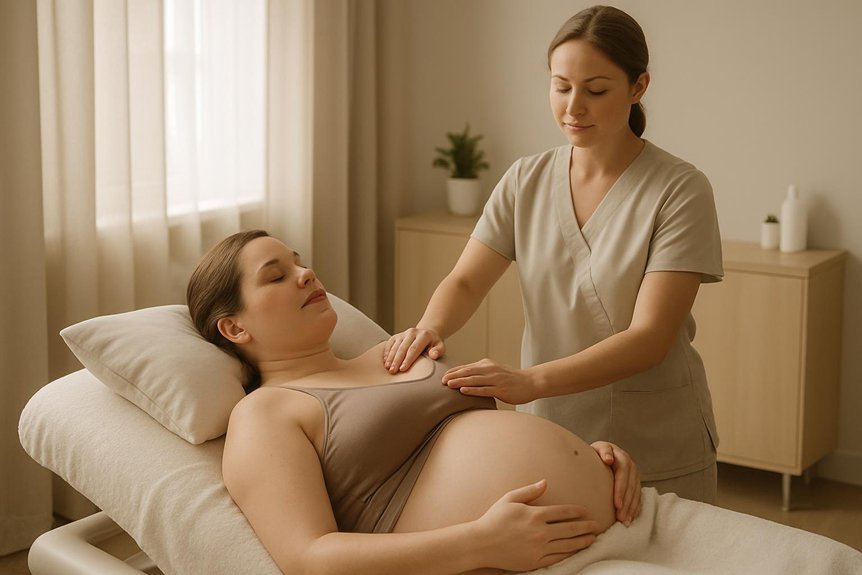
While pregnancy alters comfort and mobility, the team at Spa & Massage adapts every session to support maternal safety, dignity, and relaxation. Therapists use evidence-based positioning: left-side lying or semi-reclined with adjustable bolsters to reduce vena cava compression, protect pelvic ligaments, and ease chest sensitivity.
Breast and chest work is only provided with explicit consent, with draping that reveals only the area being treated; clients can pause or decline any step.
Pressure is moderated to avoid oedema aggravation and nipple tenderness, using fragrance-free, hypoallergenic oils common in our clinics. Rooms are warm, softly lit, and acoustically private; doors remain closed, and only the therapist is present unless a chaperone is requested.
Appointments occur in London locations with accessible facilities, discrete changing, and post-session hydration and rest.
When to Seek Advice From a Midwife or GP
Clear thresholds help determine when professional input is needed alongside massage during pregnancy. Spa & Massage advises clients to contact a midwife or GP promptly if breast changes include a new hard, fixed, or rapidly enlarging lump; skin dimpling, peau d’orange, or nipple inversion; persistent unilateral pain unrelieved by gentle techniques; bloody, foul‑smelling, or pus‑like discharge; fever, chills, or spreading redness suggestive of mastitis; sudden swelling with marked asymmetry; or unexplained weight loss or night sweats.
Immediate care is also prudent after chest trauma or if there is a personal history of breast cancer or high‑risk lesions.
Their therapists pause local treatment and signpost medical review whenever red flags appear. With routine tenderness or blocked ducts, they recommend gentle strokes only after clinician guidance, prioritising comfort and safety.
Conclusion
In summary, breast massage during pregnancy can be safe and supportive when performed gently, with attention to trimester, symptoms, and medical guidance. Evidence-informed techniques may ease tenderness, aid lymphatic comfort, and prepare for breastfeeding, while clear contraindications help protect parent and baby. Like adjusting a sail to the wind, small, precise changes in pressure, positioning, and oil choice maintain comfort and safety. If pain, lumps, redness, fever, discharge changes, or risk factors arise, consultation with a midwife or GP is advised.
